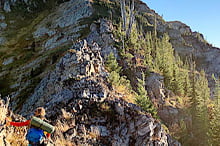No products in the cart.
The Sacred Altars

Tales of Megaliths in the Mountains
By Mike Blackbird
When my brother Jerry was interested in something, he was totally invested, and his enthusiasm was infectious. In 1979, when I visited him in Idaho from California, where I was living at the time, he had become excited about the prospect of finding megaliths in the mountains of northern Idaho. Jerry was a helicopter pilot, and he intended to conduct an aerial search that summer.
Typically, he’d already done a lot of research, compiling books on the subject, notes, a topographical map, and, crucially, a long article in a 1977 edition of the now-defunct Kellogg Evening News.
The monuments called megaliths, built of large and heavy stones by prehistoric people, are found throughout the world. Famous examples include Stonehenge in Britain, the Egyptian pyramids, and the megalithic platforms on which the huge human statues of Rapa Nui were placed. Thousands of megaliths span the North American continent.
This content is available for purchase. Please select from available options.
Purchase Only
Purchase Only

